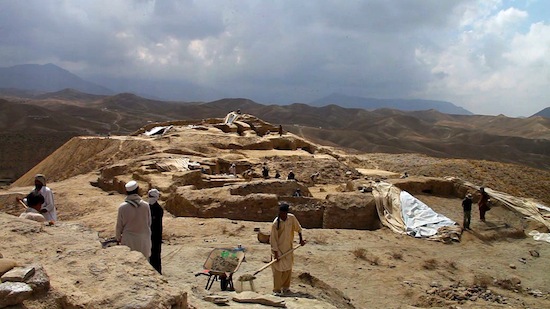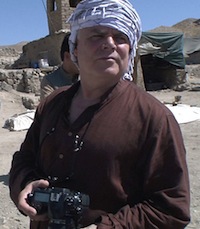
Plans for a massive copper mine threaten the site of Mes Aynak, an ancient monastery in Afghanistan. Archaeologists fear that artifacts dating to the Bronze Age will be destroyed.
Photos courtesy of Brent Huffman
J. Mark Kenoyer stands on a windswept peak in Logar Province in eastern Afghanistan, his head wrapped in a traditional scarf against the harsh sun.
As he chats in a mixture of Urdu and Pashto with an Afghan archaeologist, it’s easy to see why documentarian Brent Huffman wanted the University of Wisconsin-Madison professor of anthropology to appear in his upcoming film about Mes Aynak, a 2,600-year-old Buddhist monastery.
Huffman needed someone who could articulate what will be lost when a new copper mine destroys this archaeological treasure. Kenoyer, at home in the region and with the culture, was his man.
The camera follows Kenoyer’s gaze across a vast complex of stone houses, passageways, burial chambers, and stupas (ceremonial monuments), dotting the desolate landscape as far as the eye can see.

Kenoyer
“This whole mountain contains artifacts,” says Kenoyer. “They buried manuscripts inside the buildings that could tell us about life and commerce along the Silk Road. Archaeologists need 30 years to properly excavate this site.”
Unfortunately, all they have is three months.
The China Metallurgical Group said in June it will close the site to archaeologists and begin preparing the area to make way for a massive copper mine that will bring in an estimated $100 billion in revenue, of which $3 billion will be paid to the Afghan government. Archaeologists fear that everything will be destroyed, including artifacts from undiscovered levels beneath the Buddhist monuments that may date back to 3000 B.C., during the Bronze Age.
Though the mine will go forward no matter what, there is still a chance — a small chance — that the excavation site could exist alongside it.
“Miracles can happen,” says Kenoyer, which is one reason he agreed to travel for the first time to the heart of Taliban country to help make a dramatic case for preserving this vital piece of global heritage.
Around the world, archaeological sites are threatened by war, environmental degradation, mining, dam-building, and even mass tourism. Rebellions in Libya, Syria and Mali have endangered not only the lives of millions of people, but thousands of years of human history.
“This is a global problem. The question can be put to everyone on the face of the earth: What is worth saving?”
William Aylward
Archaeologists and anthro-pologists play an increasingly vital role in communicating not only the importance of what will be lost, but the potential benefits to tourism and culture if it can be saved. In the digital age, the impact of a well-crafted story, or petition, or documentary can resonate much further than it might have 15 years ago.
Aylward has witnessed this firsthand. In 2002-04, he was involved in documenting the rescue of thousands of artifacts from Zeugma, an ancient Greek and Roman frontier city on the Euphrates River in Turkey. One-third of the city was flooded by a massive hydroelectric dam.
“It took the threat of destruction to bring the site worldwide attention,” he says. “The New York Times ran a front-page story on it. Because of that, the Packard Humanities Institute launched a five-month rescue operation, with hundreds of archaeologists working as the waters rose in the river valley.”
Now, he says, Zeugma is on the radar of Turkey’s Ministry of Culture and Tourism. Archaeological teams now visit the site every summer, and the looting that had plagued the neglected site has ceased.
Aylward, whose Troy expedition has attracted much media attention, says scholars must walk a fine line between advocacy and courtesy.
“I always remember — and I impress upon my students — that we are international guests,” he says. “We are there at their invitation and subject to the limitations that they might impose. I respect those limits because I want to go back.”
Though the mine will go forward no matter what, there is still a chance — a small chance — that the excavation site could exist alongside it.
In war-torn or famine-devastated countries, archaeologists’ dilemma — and that of organizations like UNESCO, which helps countries create Global Heritage Sites — is how to advocate for ancient culture in places where people are just trying to survive.
That’s where language skills, ease with the media, and respect for local people can make a difference.
Take Kenoyer, an expert on the Indus Valley civilization. For 30 years he has been excavating at Harappa, Pakistan, focusing on ancient technologies, economics, and religion. He has also appeared on Pakistani TV and speaks fluent Urdu. All this made him an attractive figure to Huffman, an Emmy Award-winning documentarian.
“I knew I wanted him to be part of my film as soon as I met him,” says Huffman. “He’s a world-renowned archaeologist with a rare ability to accomplish things in impossible situations.”
Huffman drove with Kenoyer around Kabul and into the hills, stopping to film the anthropology professor as he asked people about the threat to Mes Aynak. Young men crowded close outside a walled garden in Kabul, eager to talk. But within minutes a policeman was on the scene, ordering them to disperse.
“More than five people gathering in one place is considered unsafe,” says Kenoyer.
But Huffman had what he needed: conversations across the barriers of language and culture, showing that Afghans did indeed know about the impending destruction at Mes Aynak —and they were disturbed by the lack of intervention.
“It’s their heritage, and their lives, impacted by the loss of these materials,” says Kenoyer.
Huffman, an assistant professor of journalism at Northwestern University, directed and produced “The Buddhas of Mes Aynak,” which he plans to submit to film festivals this summer (it is already being screened at universities). Meanwhile, Kenoyer has convened archaeology colleagues in five South Asian countries to discuss the site. He also plans to bring it up during a visit to the Chinese Academy of Science this spring.
Already, word has spread: a global petition to save Mes Aynak has garnered more than 60,000 signatures.
—Mary Ellen Gabriel
No comments:
Post a Comment